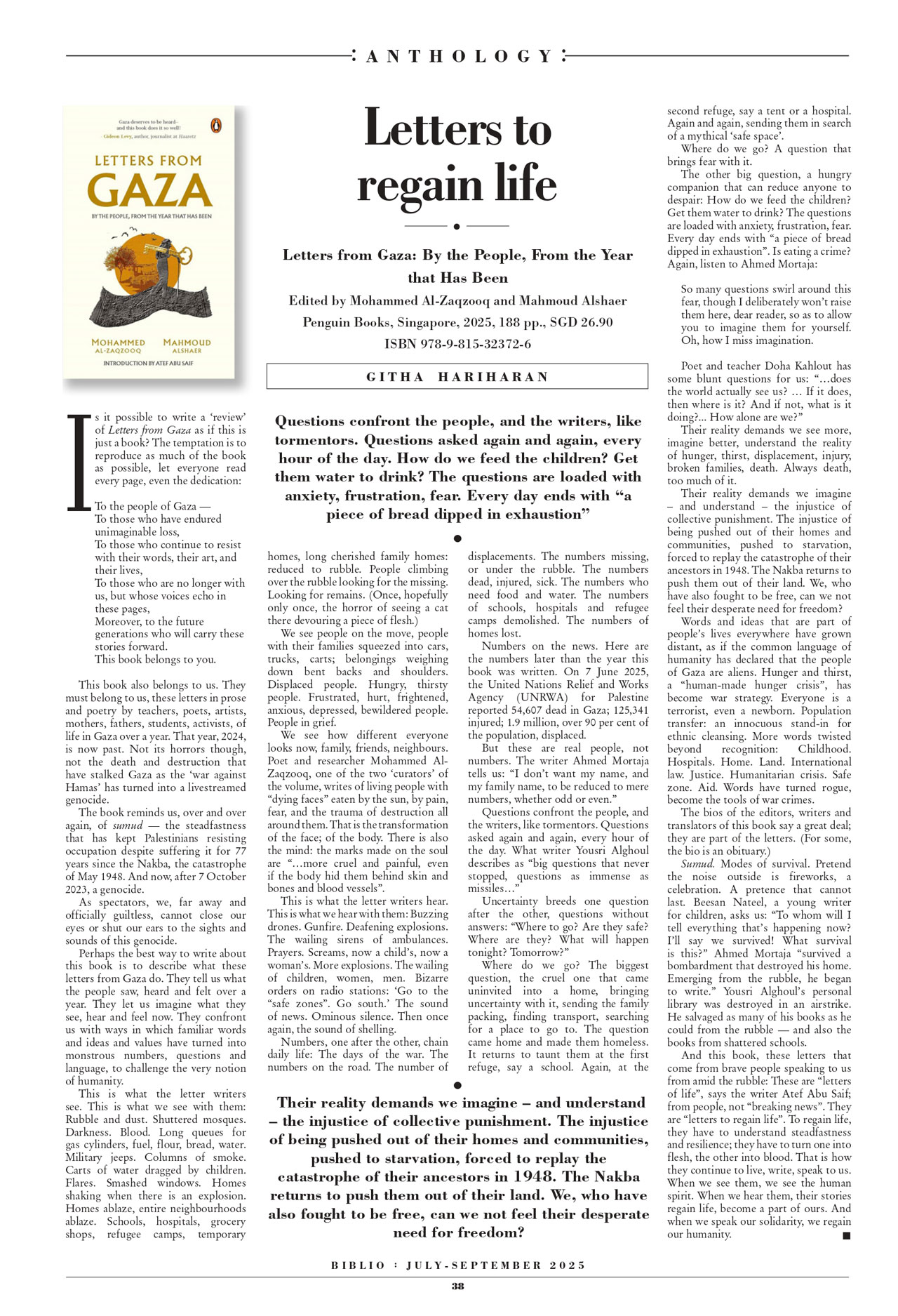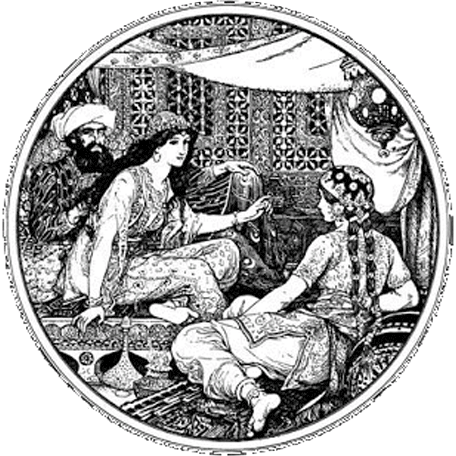 Image courtesy: Google Scheherazade Tutorial
Image courtesy: Google Scheherazade Tutorial
 Image courtesy: Google Scheherazade Tutorial
Image courtesy: Google Scheherazade Tutorial
Remembering Scheherazade
I have always been fascinated by Scheherazade. Going by the evidence, this is a fascination shared by many others over the centuries.
The story is irresistible. There is a man who rules, as so many have done and as so many do. And like many powerful men, this man, Sultan Shahriyar, is vulnerable, and his vulnerability makes him madly cruel. Shahriyar has decided that the only way to cope with the fear of betrayal – in his case, by his wife – is to bed a woman, then kill her before she can be unfaithful to him. The sultan’s fear is specific, and so is his strategy to contain it. But the situation that results asks a universal question. What do you do when a ruler, or an official, or someone in a position of power and responsibility, uses force to extract obedience? When he sheds blood to keep his authority from being challenged? It’s the response offered to this question that makes the story so perfect. In this battle with violently oppressive power – the worst kind of power – the weapons are made of words. The lone soldier on the battlefield is a young woman.
Scheherazade undertook the most unique mission ever undertaken by either a subject or a storyteller – saving her life, and that of her fellow-citizens, through her body of stories. At the heart of the Scheherazade story, a story that has travelled in so many different forms to different parts of the world, is this oddity that needs to be explained in some way or the other. In this story of a subject bringing a ruler to his senses, a story of a storyteller reconciling her audience to the difficulties of continuing with normal life despite fear of betrayal, it is not a man, the sultan’s venerable wazir for instance, who performs the difficult task. It’s a woman.
Though Shahriyar’s tactics are somewhat extreme, his situation – the man of power who has become a despotic enemy of the people – is not really unfamiliar to us. It’s Scheherazade’s position that is trickier to describe, though her story as a speaking fighter, an activist who talks the tyrant into putting reason before force, has had such a strong resonance for people through the ages. We too share Scheherazade’s situation — but only in the “real life” of dreams, of imagination, of possibility. I say “real life,” because without a belief in the possibility of reason containing violence, what business do we have to continue living? It would be impossible to live with the prospect of being ruled, of being subjected by this or that oppressive authority, if we could not see the possibility of a rescue mission.
To me, the most interesting fact of the Scheherazade story is not just that it is a storyteller who undertakes such a rescue mission, but a woman storyteller. My suspicion is that this explains much of the fascination with the figure of Scheherazade – and much of the need to explain her, tame her, and in reaction to this domestication, re-appropriate her into a feminist icon.
Whether you are reading Borges or a bowdlerized children’s book, or seeing the “exotic” harem-world of Scheherazade in famous European paintings or a B-grade Hollywood film on the Arabian Nights, you come face to face with a reconstruction of Scheherazade. And the way in which she is reconstructed – how she looks, what her weapons are, says a great deal about whoever is doing the imaginative remembering.
Fatema Mernissi, the sociologist who has written remarkable books for a larger readership, has written with insight and humour about the way Scheherazade has been viewed in different parts of the world. In a book called Scheherazade Goes West: Different Cultures, Different Harems, Mernissi describes some of the ways in which Scheherazade becomes a type – an imaginary, exotic type – in the ballets, paintings or literature far from home.
There is, for example, a recent (1985) edition of Scheherazade’s tales illustrated by a German artist. “The book,” Mernissi says, “had a gaudy blue cover on which sprawled a huge nude woman endowed with massive buttocks and Medusa-like black hair that swirled around her distended bosom.” (Not surprisingly, the subtitle of the book refers to “sexual desire and voluptuousness” in the Arabian Nights.) Mernissi is puzzled by the way this Scheherazade looks. Where she grew up, “to be plump is a sign that a woman is in control of her fate.” With a violent husband, Scheherazade was in constant fear of her life; she must, therefore, have been strained and thin. (When I wrote my novel When Dreams Travel, I decided to make Scheherazade strong, but heavier than the beauties of Hollywood harems. It seemed to me that Scheherazade would have to be in top physical condition to go to battle.)
Whether Scheherazade was thin or fat becomes a minor bone of contention when Mernissi sees a rendition of the popular Scheherazade ballet, originally choreographed by Sergey Diaghilev. In the original tales, Scheherazade’s body is hardly mentioned, though her learning is repeatedly stressed. In the German ballet, however, Scheherazade is all body and voluptuousness. But if the original Scheherazade had nothing more than this to offer, what would have happened to her? Mernissi is very sure “she would have been killed if she had disrobed like a Hollywood vamp or Matisse’s odalisque and stretched out passively on the king’s bed. This man is not looking for sex, he is looking for a psychotherapist.” What Scheherazade had to do was disarm a killer with dialogue, not seduce – something any of the women who went before her could have done.
So the next time we encounter Scheherazade in a story or a painting or a film, it may be useful to remember Mernissi’s summing up of the strategy Scheherazade had to use to be a civilizing agent – convincing the king that reason is more effective than violence. “Scheherazade had to master three strategic skills: control over a vast store of information, the ability to clearly grasp the criminal’s mind, and the determination to act in cold blood.” The first skill is intellectual — Scheherazade had to know reams of poetry, the sayings of the wise, and improvise a great deal in terms of content as well as narrative device. But knowledge alone could not have helped her. She had also to draw on some more “psychological talents” that would change the criminal’s mind by using words alone, something like the highly trained specialist who speaks to the anti-social holding a hostage. Scheherazade had to be a strategist, and guess accurately what would be the unbalanced criminal’s reaction or next move, even as she talked into the night. Finally, she had to sustain nerves of steel that would help her control her fear — that any moment she would lose her listener’s interest and he would revert to his blood-spilling practices. In short, in this nightly interaction between her and the king in their harem-prison, she had to lead though she was the prisoner, the subject and the woman. Being led would only mean that her neck – and the necks of other women – would be that many inches closer to the sword.
First published in Telegraph, Kolkata, August 2005
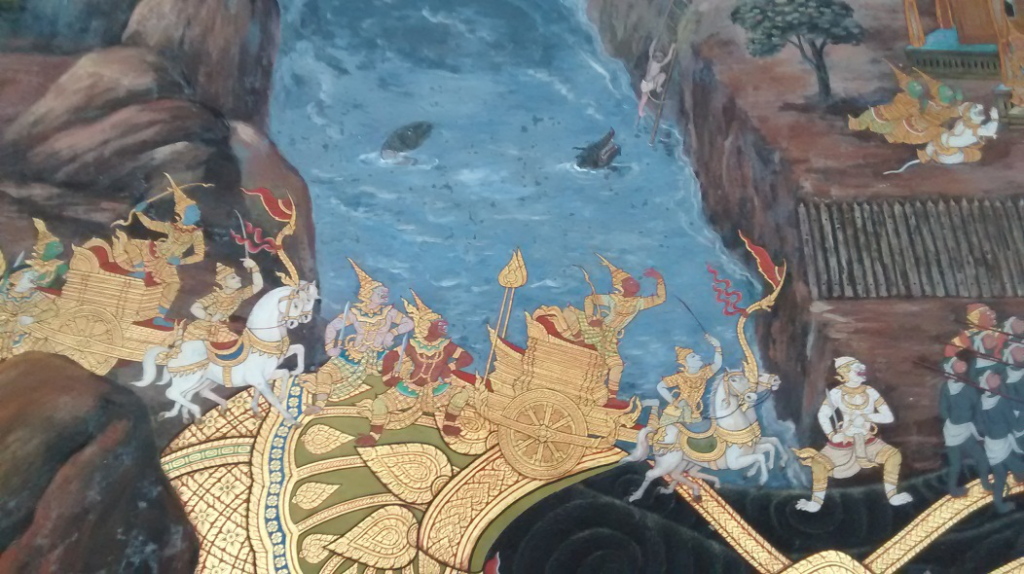
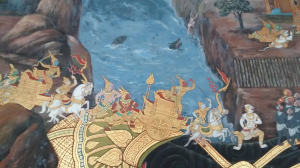
Learning another Ramayana in Bangkok
There is a sharp self-reflexive question at the end of some versions of the Ramayana: “How many Ramayanas have there been?”
In his essay “Three Hundred Ramayanas: Five Examples and Three Thoughts on Translation” 1, Ramanujan responds to this question by tracing several branches of this banyan tree of an epic. For the past 2,500 years or more, the Ramayana has lived in multiple versions in at least 22 languages across India and Asia. The epic has spoken to people through poems, myths, sculpture, mask plays, puppet plays, shadow plays, music, dance, TV serials, films and comic books.
Can the hanging branches of a banyan turn invisible? Can an epic be shrunk to size?
In 2011, Ramanujan’s essay was dropped from the syllabus of Delhi University’s B.A. Honours course as a result of protest and vandalism by “nationalist” Hindu groups. These groups were led by the student wing of the Bharatiya Janata Party, the party that rules India today.
The protesters claimed that the idea of multiple Ramayanas would “negatively influence the minds of young undergraduates”. Their real problem is that the essay effortlessly debunks the pseudo-cultural (and pseudo-religious) propaganda that there is one “authentic text” of the epic. The right wing has always feared the plurality at the heart of life in India and, indeed, any Asia we may choose to either remember or forget. As the epic travelled across classes, regions, communities, languages and dialects within India, then regions outside India in Southeast Asia and North Asia, it adapted and shape-shifted. The text became a manifestation of the many Indias contained in every little slice of India, and of the many Asias layering every part of Asia. There is a variety of “tellings” in Tibet, Thailand, Burma, Laos, Cambodia, Malaysia, Java and Indonesia.
But the past in India today is the site of slippery memory games. If the past is reduced to a strand of a complex narrative, or to one authoritative (often invented) narrative, even a travelling epic that needs to multiply itself can be shrunk down to the desired size. A. K. Ramanujan, curator of plural texts, narrator of plural India, will always be a threat to those who want to imagine a homogenous story, myth, history, literary text; or an officially sanctioned view of India in the singular.
Ramanujan makes it clear that the Ramayana can never be merely “official”. The Valmiki Ramayana was an epic first. It may have become a sacred text for some people over a period of time. But even in this case, we could ask a few pertinent questions. Who are the people who made it a sacred text? And who were they doing it for? Most important, what about all the people for whom the text did not become sacred — people who continued to recite, sing and story-tell their own legacies of the epic?
As epic, Valmiki’s Ramayana is bound up with a sparkling array of other Ramayanas, many of which recount stories that are potent even when they are nugget-sized. One story, for example, describes how sixteen thousand sages want to turn into women because they have fallen in love with Rama. Rama asks them to wait — he has taken a vow of monogamy in this life. But when he comes back as Krishna, he tells them, they can be his beloved cowherds.
In the past, Hindus did not react with shrill intolerance to this range of tellings of the Ramayana — whether the epic was recounted by Kamban, Kritihas, or Tulsi. These were accepted as kavya, and then as sacred texts; their differences with Valmiki were known. In our times, we might pose some more pertinent questions to those who want one authoritative “sacred” reading of the Ramayana. Why do they want to break with tradition? Why do they pretend to “defend” tradition and culture by turning both upside down?
In the Jain retellings, Ravana is a tragic figure, killed by Lakshmana, not Rama. In a Kannada folk Ramayana, Ravula (the Ravana figure) becomes pregnant, and at the end of nine days, “sneezes” Sita into existence. (In Kannada, the word sita also means “He sneezed.”) This motif of Sita as Ravana’s “daughter” occurs elsewhere — in, for instance, Jain stories, Telugu folk traditions, and in several Southeast Asian Ramayanas. “The oral traditions,” writes Ramanujan, “partake of… themes unknown in Valmiki.” How, asks Ramanujan, do these tellings and retellings, oral and written, epic and tale, relate to each other?
They do it in ways that impoverish a part — one story or tradition or genre — if it is mistaken for the whole. The grand saga of the epic has to be viewed along with their homely versions, folk tales and traditions that cut down to size the grand narratives for daily consumption. Love, lust, death, the afterlife — nothing is too big for the debate conducted among these tales, and between this earthy body of tales and the more revered “classical” texts and traditions. Acknowledging the familial relationships among all the possible types of “tellings” means reaping the reward of an astonishing body of systems and counter-systems; traditions and alternative traditions; tales and counter-tales; private and public lore; a large and amorphous body that can never quite be complete as long as people continue to “complete” the telling for their times and lives.
Perhaps the biggest gift Ramanujan the go-between has given us through his work on our rich heritage is showing us how important it is for culture to travel; to give and receive. Almost as a recipe for world literature, Ramanujan quotes the 12th century poet and historian Kshemendra:
A poet should learn with his own eyes
the form of leaves
…his mind should enter into the seasons
he should go
among many people
in many places
and learn their languages.2
I could hear Kshemendra’s voice in my ear when I was in Bangkok recently. My life as an Indian, and my life as a writer and reader, only has meaning if I can hold the multiple possibilities of a narrative as the self-evident truth of all storytelling. The time I spent on the grounds of the Wat Pra Kaew, the Temple of the Emerald Buddha in Bangkok, brought home the truth of Kshemendra’s words, and Ramanujan’s essay on the many Ramayanas. The walls of the Wat Pra Kaew, lavishly decorated with paintings representing stories from the Ramakien, confirmed my conviction that the same text lives and breathes as another text, among different people, in many places and languages.
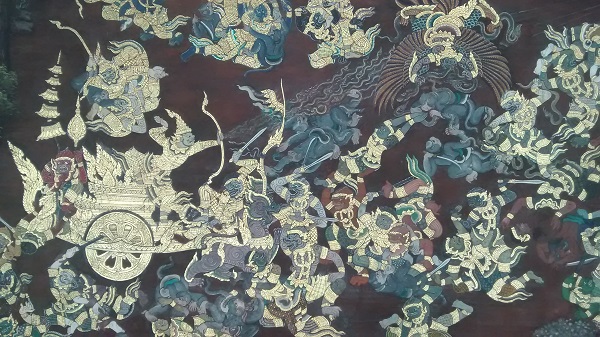
The Ramakirti (The Glory of Rama) is usually referred to as the Ramakien (The Story of Rama) in Thailand. Archaeological evidence of the story dates from the 14th century in the Wat Phra Rama at Ayuthia.3
Ayuthia (Audhya, Ayudhya, Ayutthaya) — the Thai Ayodhya — was a riverine island city-state founded in 1350 AD by Prince U-Thong who took the title Ramathipodi (Rama the Sovereign). For some 417 years, Ayuthia was the “heart of Siam” till it was destroyed during a battle with Burmese invaders in 1767. A new capital was subsequently established on the site of a riverside market town called Ban Kok (Village of Wild Plums). King Rama I made a deliberate attempt to recreate the Ayudhyan way of life, and this included sponsoring, and closely supervising, a written version of the Ramakien. The version was in verse, and it was meant for secular use to be performed as masked drama.
In present-day Thailand, images and tales from the Ramakien are alive in a range of locations and forms, from ubiquitous state symbols such as the garuda, to Lakhon classical drama, Khon masked dance dramas, Nang shadow plays, Buddhist temple statuary, decorative elements and murals, illustrative material for religious manuscript cabinets and talismanic tattoos. Since 1902, the Ramakien has been part of the Thai school curriculum; it is considered the “national epic”. The Ramakien is Thai, not some Thai version of the “Indian” Ramayanas.
As in India, some readings of the Ramakien recall the emphasis on the sacredness of the text. But the difference is also fairly sharp: the Thai Ramayana is a narrative with its own audience, and its own emphasis on adventure, magic and, ultimately, how men and women should live in the real world. In effect, the Thai Ramayana tells us that the sacred tellings have not diminished the space for “non-sacred” retellings of the epic.
In his essay on the many Ramayanas, Ramanujan points out that the different Ramayanas are better described as “tellings” rather than “versions”, which may imply that one telling can be valorised as the authoritative mother-text. The tellings obviously take on the storyteller’s language, landscape, clothes, food and customs. Each telling is the result of a particular travel route; the Ramakien, for instance, owes more to the Tamil telling than Valmiki’s. The plot also has elements from the Malay Hikayat Sri Rama (The Annals of Sri Rama), the Thai prose work Narai Sip Pang (Ten Incarnations of Vishnu), and certain sections of folk tales from the Laotian Rama Jataka. Most of all, says Ramanujan, it’s not just differences in story detail that marks each telling as a unique text. It’s the style, tone, texture and discourse. Together, these make the import of the story different in the telling.
This is exactly what the Ramakien illustrates.
As I looked at an almost endless series of detailed, glittering paintings in the Wat Pra Kaew, there was much that puzzled me. I could make out the usual outline of the story — Rama (Phra Ram), Sita (Nang Sida) and Lakshmana (Phra Lak)going to the forest; Phra Ram and Phra Lak slaying demons; Nang Sida’s abduction; the war; Hanuman (Anuchit) and the monkeys helping Rama; Nang Sida’s recovery and her trial. But there was a great deal I could not recognize in terms of episode and character. I met, for instance, Benjakaya, Suphanna-Maccha and Maiyarab for the first time in the Wat Pra Kaew paintings of the Ramakien.
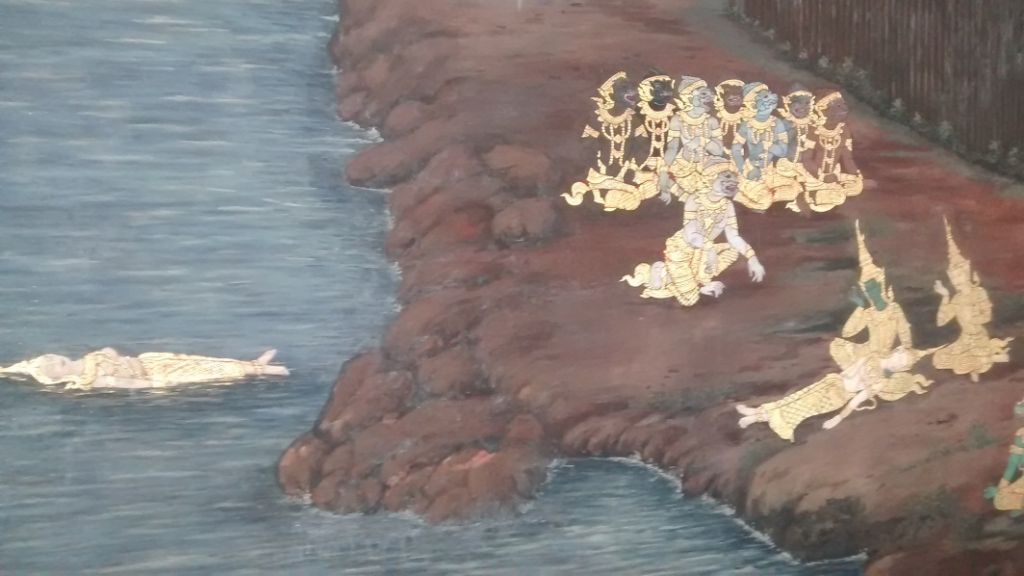
When Tosakanth (Ravana) begins to worry about the way the war is going, he decides to fool Phra Ram into thinking Nang Sida is dead. Perhaps this will blunt Phra Ram’s appetite for battle. Tosakanth orders his niece Benjakaya to transform herself into Nang Sida, pretend to be dead, and float in the river past Phra Ram’s camp. Benjakaya studies Nang Sida so well that Tosakanth is filled with lust when he sees her transformed appearance. With some difficulty, Benjakaya manages to convince him that she is still his niece, and escapes his clutches to carry out his order. When Phra Ram sees the dead Benjakaya-Nang Sida floating in the river, he is heart-broken. But Anuchit is suspicious: the body is floating against the current. He knows Nang Sida is impervious to fire; so he sets alight Benjakaya-Nang Sida. Benjakaya escapes into the skies, but Anuchit chases her though the clouds. They are “married” (mid-sky?) and she comes back to the camp as his ally.
Another female relative of Tosakanth is enlisted to prevent the building of the causeway to Lanka. Tosakanth asks his mermaid daughter Suphanna-Maccha to go do her disruptive best. As usual, Anuchit sees what is happening, and as usual, he converts another female enemy into an ally. Suphanna-Maccha later has a son, Macchanu, who resembles Anuchit.
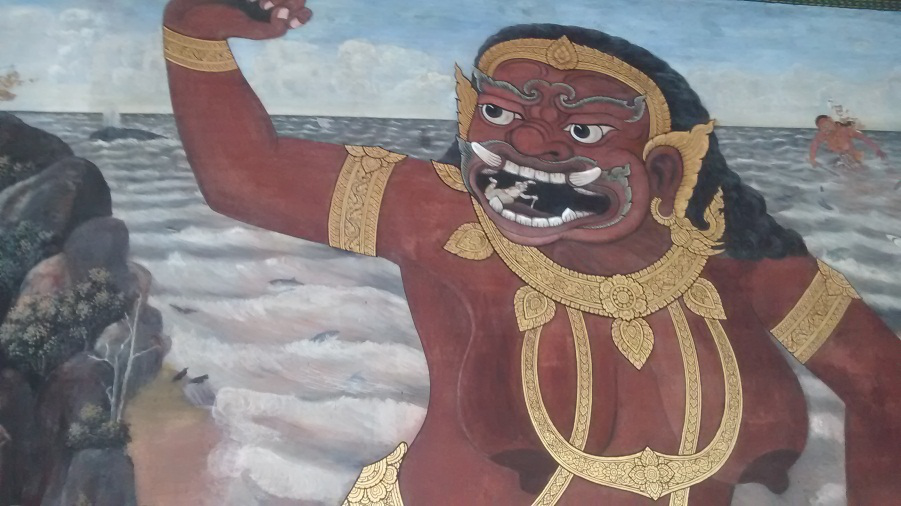
Tosakanth then orders Maiyarab of the underworld to put Phra Ram to sleep and carry him away. There are no prizes for guessing who saves Phra Ram and kills Maiyarab. In fact, I was struck by how ubiquitous Anuchit is in the tales the paintings told. He is everywhere visually. He is the actor who precipitates dramatic change; at the end of the tale, Phra Ram gives Anuchit a kingdom of his own.
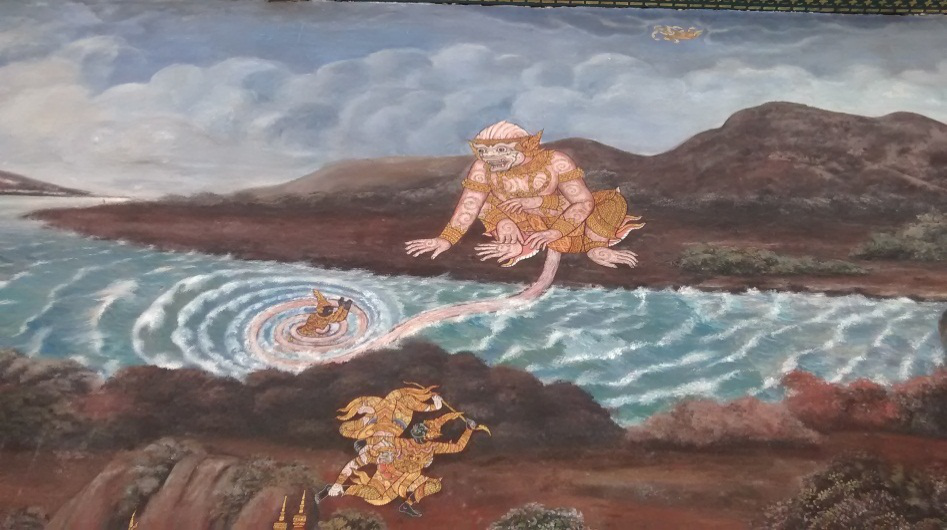
Anuchit is an invincible warrior; he has an unbreakable bond with the ruler. His strength, his superpowers, can take on all kinds of enemies, as well as all kinds of women. There is an undercurrent to a number of his amorous encounters — he turns the female enemy, whatever demonic form she assumes and whatever magic she knows, into a submissive ally.
Episodes and details in the Ramakien make for stark or subtle shifts in mood and characterisation. Details, such as Phra Ram and Nang Sida falling in love at first sight before the archery contest, are reminiscent of the Kamban Ramayana. The focus of the Ramakien, though, is the war: layer upon layer of intrigue and strategy, destruction and magic, unfold the story. I saw spy scenes, interminable battle scenes. I was not surprised to learn that the war campaigns make up the favourite themes of the Nang and Khon plays. But I was surprised to learn that Anuchit and Ongkot (Angada) pretend to defect to Tosakanth and steal the receptacle that contains Tosakanth’s soul. When Phra Ram’s arrow strikes Tosakanth’s chest on the battlefield, Anuchit crushes the soul in the receptacle. This is what finally kills Tosakanth.

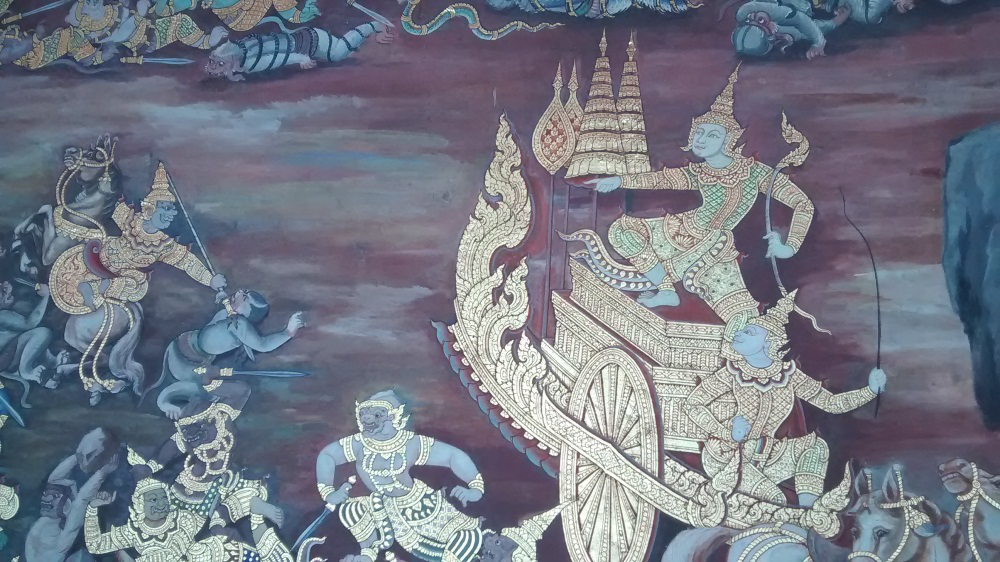
Perhaps one the most distinctive features of the Ramakien, other than Anuchit’s substantial role, is Nang Sida’s life — her birth, her banishment, and her final reunion with Phra Ram.
Nang Sida does not appear miraculously in the furrow for Chanok (Janaka) to adopt her, as in the Valmiki or Kamban tellings. The Ramakien’s Sita is related to the Jain and oral tellings: Nang Sida has a link at birth to Tosakanth. When the gods decide that Vishnu and Lakshmi must be reborn as Phra Ram and Nang Sida, a magical rice dish is sent to earth. Three portions go to Tosaroth’s wives, and they give birth to green-faced Phra Ram, scarlet-faced Bhrot, gold-faced Lak and purple-faced Satrud. The fourth portion, via a divinely managed theft by a crow, is flown to Longka, to Tosakanth’s wife, Montho. She gives birth to Nang Sida.
The instant Nang Sida is born, she cries thrice: “Destroy the demon race!” A disturbed Tosakanth asks his brother to cast a horoscope for this born rebel. The professional opinion is that Nang Sida will cause the demons great misfortune. Tosakanth wants to kill her on the spot. But the mother stands in his way. You will have to kill me before you kill my daughter, she says. The horoscope-casting brother (Pipek, who will later go over to Phra Ram’s side) suggests Nang Sida be put into a silver casket and floated downstream on a river. This is an ancient practice to do away with evil.
A lotus rises; it keeps the casket afloat. Schools of fish escort the casket till it passes a hut where the hermit Chanok, erstwhile King of Mithila, lives. He places the baby under the care of forest spirits and buries the casket for safety. Chanok meditates for many years, but enlightenment is elusive. He returns to Mithila and his childless queen. But first he arranges for the ground to be ploughed to locate Nang Sida, now a sixteen-year-old daughter of the earth.
The banishment of Nang Sida and her reunion with Phra Ram are also distinct in detail — as well as in the unspoken shaping of human character.
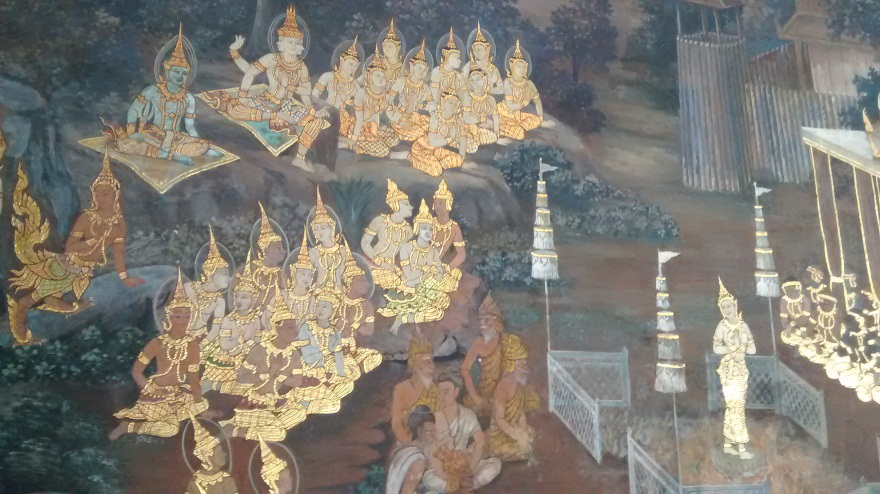
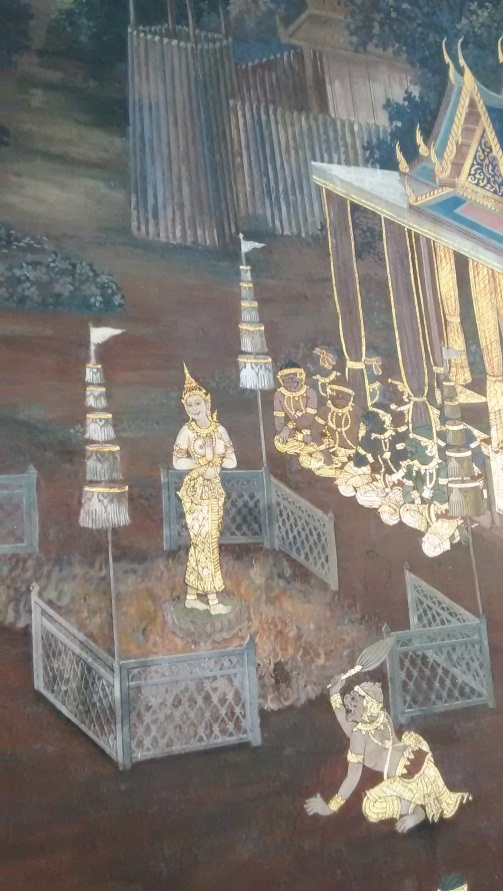
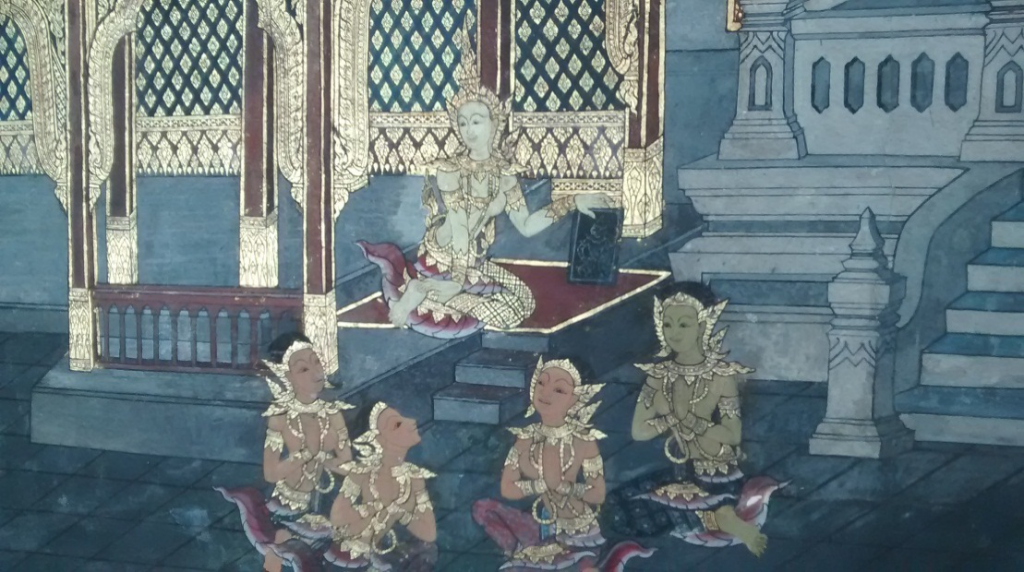
After the war, Nang Sida undergoes a trial by fire and is exonerated. (Phra Ram sets alight the logs of wood with his arrow.) But in Ayodhya, Nang Sida has a new maid. The maid is actually a demon called Adun, and she is the daughter of Surpanakha (Sammanakkha). The daughter has not forgotten how her mother was disfigured. She coaxes Nang Sida to draw a portrait of Tosakanth. The portrait is indelible; Nang Sida hides it under Phra Ram’s bed, and it fills his body with a strange heat till he discovers it. Phra Ram doubts Nang Sida’s purity a second time. He orders Phra Lak to take Nang Sida to the forest and kill her. But Phra Lak spares Nang Sida, and returns to Phra Ram with the heart of a deer.

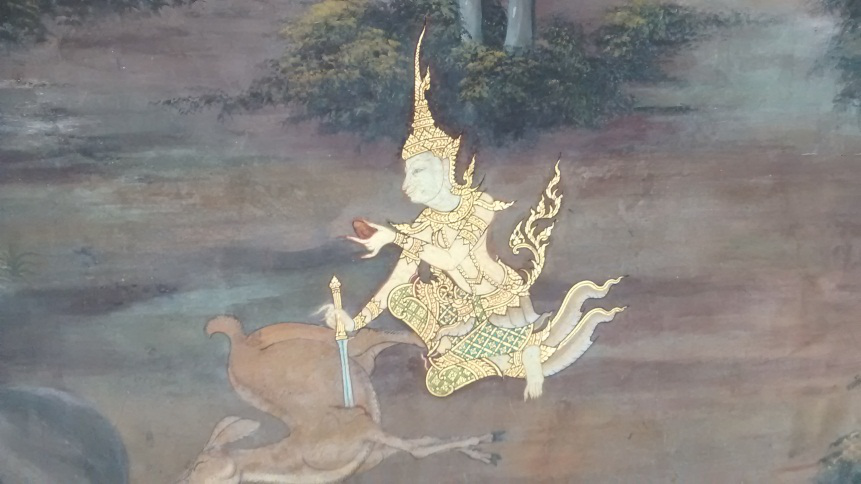
Meanwhile, Nang Sida is in the care of Sage Wachamarik, yet another surrogate father. This father will later create a miraculous clone of her son so that Nang Sida has “twins”. Phra Ram finds out that his family is alive and tries to persuade them to return. Nang Sida refuses, but she lets her sons go with their father. Phra Ram then sends Anuchit to say the king is dead, and Nang Sida should come to Ayodhya for the cremation ceremony. When Nang Sida finds out that she has been tricked, she is furious. Rather than live with Phra Ram, she prefers life in the underworld. Finally Isvara breaks the impasse; he intervenes, and gets Phra Ram and Nang Sida married all over again.
Phra Ram is all too human in the Ramakien. Anuchit, the favourite of the Thais, is a brave, shrewd and happy warrior, neither celibate nor saintly, and, in the words of S. Singaravelu, “an embodiment of all that expresses the freer and the unrestricted aspects of life”. Tosakanth is complex; he is strong and resourceful, and his end is an occasion of sadness, as is his wife’s thwarted motherhood. The major characters of the Ramakien, says Singaravelu, “represent human life in its different facets, and the Thai people regard them as examples of… human society, and this is the reason for the continuing popularity of the Rama legend” in Thailand. Singaravelu goes on to show that though several episodes and motifs in the Ramakien are related to other tellings, such as Kamban’s, or the Jaina, Bengali and Malay tellings, “the stories of Rama, transmitted to the Thai people through the shadow-play as well as literary and oral sources, have not only been extended, but also transformed into a distinct work of literature.”4
The Ramakien is not just a distinct telling in literary terms. There is also a distinct way in which the epic lives in Thailand — achieving a delicate balance between an all-pervasive literary and performative strand on the one hand, and an iconic and cultic strand on the other. In response to the question of whether the Ramakien can be considered a “Hindu” or “Buddhist” text, Frank E. Reynolds outlines an argument against viewing the Ramakien as an unambiguously Hindu text, or perhaps a Hindu text at all. He refers to the epilogue attached to the original composition by King Rama I: “The writing of the Ramakien was done in accordance with a traditional tale. It is not of abiding importance; rather, it has been written to be used on celebrative occasions. Those who hear it and see it performed should not be deluded. Rather, they should be mindful of impermanence.” Rama I uses the word “lailong” for the notion of delusion — a direct translation of the Pali “moha” that refers to one of the three pre-eminent Buddhist vices (delusion, anger and greed). “Rama I explicitly highlights his own conviction that those who participate in the Ramakientradition can and should approach the Ramakien story in a way consistent with Buddhist teachings and insight.”5 While
“…the Ramakien versions of the Rama story do not exhibit the full-fledged Buddhist structure characteristic of earlier Buddhist tellings”… “it is a tradition which self-consciously sets the Rama story in explicitly Buddhist contexts, thereby giving it an explicitly Buddhist significance. In the literary and performative strand of the tradition, the Buddhist significance remains relatively muted and largely audience-dependent. In the iconic and cultic strand, the vision of Rama as a royal hero who embodies Buddhist values is vividly portrayed for all to see. Coexisting and subtly interacting, these two strands of the Ramakien tradition have, over the past two centuries, maintained the story of Rama as an integral, Buddhist-oriented component in Thai religion, culture, and politics.”6
I learnt a great deal about the Ramayana from the Ramakien. I learnt a great deal about the nature of the epic; its links with, and differences from, the sacred telling; and the vast space people have always given the travelling text.
I learnt something about home in Bangkok too. I saw, once again, how the new tradition-makers in India seek to tame and diminish a rich epic which has always been given voice through multiple narratives. Distorting tradition and culture in the name of tradition and culture: this is the irony of the way these new cultural experts squander our rich legacies. As for the stark contrast between the way the Ramakien lives among the Thais, and the way the Hindutvadis would like the Ramayana to live in India, Ramanujan has, as usual, the last word. The Thai telling, he says, is “not regarded as a religious work or even as an exemplary work on which men and women may pattern themselves.”7
This essay was first published in Guftugu, the e-journal of culture published by the Indian Writers Forum.
Notes:
I would like to thank Romila Thapar for her comments on an earlier draft of this essay.
1. A. K. Ramanujan, “Three Hundred Ramayanas: Five Examples and Three Thoughts on Translation”. Richman, Paula, editor. Many Ramayanas: The Diversity of a Narrative Tradition in South Asia. Berkeley: University of California Press, c1991 1991. (22-48) http://ark.cdlib.org/ark:/13030/ft3j49n8h7/
2. From the Sanskrit poem by Kshemendra, a poet, satirist and historian. The poem is from Kavikanthabharana, a book on the education of a poet.
3. The Poetics of the Ramakian, Theodora Helene Bofman, Monograph Series on Southeast Asia, Special Report No 21, 1984, Centre for Southeast Asian Studies, Northern Illinois University.
4. S. Singaravelu, “The Rama Story in the Thai Cultural Tradition”, Journal of Siam Society 70, parts 1 and 2, July 1982, 215-25 (reproduced in Asian Folklore Studies 44, no, 2, 1985, 269-79).
5. Frank E. Reynolds, “Ramayana, Rama Jataka, and Ramakien: A Comparative Study of Hindu and Buddhist Traditions”. Richman, Paula, editor. Many Ramayanas: The Diversity of a Narrative Tradition in South Asia. Berkeley: University of California Press, c1991, (48-59), 56-57. http://ark.cdlib.org/ark:/13030/ft3j49n8h7/
6. Ibid, 57.
7. AKR, 149.


Freedom’s Past, Freedom’s Future
One memorable voice in Second-Hand Time remembers: “On the eve of the 1917 Revolution, Alexander Grin wrote, ‘And the future seems to have stopped standing in its proper place.’ Now, a hundred years later, the future is, once again, not where it ought to be. Our time comes to us second-hand.”
Second-Hand Time. This is the title of Svetlana Alexievich’s magnum opus on “the history of the Russian-Soviet soul”. A history of the soul – or histories in this case – may sound a little pompous, but it isn’t, once we are deep into this book. Its chronicles are replete with varied human detail, personal, revelatory, vivid; and they come to us through an almost endless series of individual voices.
The interviews in this book were conducted between 1991 and 2012, but there’s a more ambitious timeline both on and offstage: from the 1917 Revolution and World War II, the USSR and the Soviet way of life, “Homo Sovieticus” before Stalin and after, to glasnost, perestroika, Russia and the new post-Soviet countries. The past lives because it is embodied in individual memories. For the most part, it is a second-hand re-living of socialism, either without or with a “human face”; or the living of either a “heady” or “feral” capitalism. But memory, whether remote or recent, is not alone on the stage. For a book so full of the past, the present is very much there. By the end, we find ourselves writing a mental afterword of Putin’s Russia today.
The sheer range of this book, its complexity of debate and human experience, makes comment on it daunting. The canvas is almost too large. The book is about the USSR and Russia. But it is also about a large map of abstractions all of us live with, and live by. In this map of colliding ideas that we recognise, very little is black and white. Freedom; ideology in theory and practice; the power of memory, conversation, debate; official history versus a “people’s history”; money; war; and always, the need for a belief system, for meaning, not just in the individual mind, but in the collective. Without grappling with all these, the book seems to say, there is no “homeland”; indeed, there is no intelligent life.
Svetlana Alexievich is aware that a canvas as large as this must be peopled, quite literally, with a spectacular, heterogonous cast if she is to bring alive the Soviet experiment and its dismantling. The book, 570 pages long, is a intricately woven tapestry of people’s voices – one account dissolves into another into another. Sometimes the storytellers are related, mother and daughter, grandfather and grandson, neighbours living practically in each other’s hair. Other times, the stories come from different places and times altogether. Alexievich’s questions are also determined to remain at the individual, human level. “I don’t ask people about socialism, I want to know about love, jealousy, childhood, old age… the myriad sundry details… It’s the only way to chase the catastrophe into the contours of the ordinary and try to tell a story… I look at the world as a writer and not a historian. I am fascinated by people.”
So she turns the canvas into an “emotional” one – where her interviewees’ voices speak of the larger stories, but almost always through small stories – love, families and neighbours, the kindness of strangers and the viciousness of fellow citizens, loss, despair, violence; sacrifice, with meaning still sometimes, empty sometimes. These stories make a textured mosaic with a thousand pieces, all interacting to insist we judge belief systems, and change, only through lived experience.
Every part of the timeline is probed from multiple perspectives so that we are left with a welter of impressions. Soviet life. There’s the grey salami, the faceless grey buildings; the bleach and rag smell of cafeterias; the fear of surveillance and the viciousness of Stalin’s camps; the never-ending quest for the motherland’s glory and the never-ending violence, battles and wars in its service. But there’s also the equally powerful comfort of shared music, education, collective ownership, ideals; the deep pleasure of books and conversation; and the comfort of an orderly life with everyone more or less equal in terms of hard work and hardship. There is, of course, the vast distance in practice between the rulers and the people; but this is nothing compared to the inequalities the movement for a better socialism, or democracy, or “freedom”, brings about.
In 1985, Mikhail Gorbachev began the first reforms under the umbrella of perestroika and glasnost. Land was restored to peasants after sixty years of collectivised agriculture. Political prisoners were freed; there was a move toward political pluralism and freedom of speech. Troops were withdrawn from Afghanistan. Dissidents such as the nuclear physicist and human rights activist Andrei Sakharov were allowed to return to Moscow. In 1991, high-ranking official attempted a putsch. Thousands of people protested the putsch, with Boris Yeltsin addressing them from atop a tank. The Central Committee of the Communist Party of the Soviet Union was dissolved. So was the Soviet Union. On December 25, 1991, the Soviet flag was lowered, and the Russian tricolour raised in its place.
Reading about the early nineties recalls for many of us responses around the world. The middle-aged Indian who felt so orphaned he shaved his head: his image, for instance, hangs in the background as we hear still-Soviet Russians recalling depression, staying in bed for eight months, forgetting how to walk.
But for a while, the heady sense of victory continues among those who have joined the protests, dreaming of greater freedom. Most people are wonderstruck by the sudden “plenty” in their midst – nothing grey any longer, so many different types of salami, jeans, vodka, shoes, bags, bras; a paradise consisting almost entirely of a well-stocked supermarket. But these things need to be bought; and it’s every man, woman and child for herself. There’s a new god to be courted, and this god has a terrifying mouth full of teeth. God Money. That old map with the shifting location of freedom grows illegible. All the new unmapped roads lead from the glory and the tyranny of the motherland, to the glory of owning things and the tyranny of acquiring money by any means. The distance between old and young increases. Alexievich says, “I asked everyone I met what ‘freedom’ meant. Fathers and children had very different answers. Those who were born in the USSR and those born after its collapse… it’s like they’re from different planets.” As the new capitalism reveals its feral face, what happens to freedom? “No one had taught us to be free. We had only ever been taught how to die for freedom.” The distance between samizdat, clandestine literature in the Soviet Union, and tamizdat, Russian writings published abroad and smuggled back in the USSR, has been bridged. But freedom, even its definition, remains elusive.
How are people to make sense of two such worlds in a lifetime? For a fifty-seven-year-old doctor, whose cherished childhood memory is of going to the military parade on Red Square on her father’s shoulders, the new Moscow is a foreign country. Everything real to her, Party cards and medals for valour, are now road-side junk, sold as souvenirs to foreigners. Not only is her beloved Moscow lost to her; she has suddenly changed nationality, from Soviet to Russian. Worst of all, she’s “one of the people who’s fallen behind”. In the latest edition of the battle where the Reds are the monsters and the Whites are the knights, she no longer knows who she is.
This sense of loss, of the past, of location, runs through the book like a sad inescapable thread. So pervasive is it, even with awareness of repressions, that there is an obsessive desire to make sense of it all. What happened? Was it a revolution or a counter-revolution? And what is to be done?
What happens is as unbearable as life in the Gulag camps or the endless memories of war and fear. Except this time, there is no glue of a belief that the word, or a motherland, or an ideology, can keep the world intact. Freedom: there are different countries now; Tajiks, Armenians, Chechens, Georgians, Azerbaijanis no longer need to be Soviet. But they have lived together to make their livelihood, their families and beliefs, for generations. Suddenly it is not just White versus Red. It is race, colour, ethnicity, religion. Prejudice, hatred, fear, violence. On the one hand, from the new non-Russians in Moscow: “We live here as though we are at war… Everywhere we go, we’re foreigners… On the other hand, from a Russian: “Life is better now, but it’s also more revolting.”
This piling of oral history, “novel-evidence”, works as “little history”. “This is how I hear and see the world – as a chorus of individual voices and a collage of everyday details,” Alexievich, Nobel Prize winner for 2015, has said. But it is almost too much. When Alexievich, a citizen of Belarus born in Ukraine and writing in Russian, makes a brief, unexpected aside, we want to listen carefully. Often, it is not enough. We long, like the people in the book, to make sense of it all. But we too are left with memories, and a yearning for a freedom that can be lived. All the same, Alexievich achieves this through her writing: though we are neither Soviet nor Russian, it is hard to read Second Hand Time without hearing our voices. Hearing our own questions about how we want to live – either as people or as a nation.
This review was first published in Biblio.
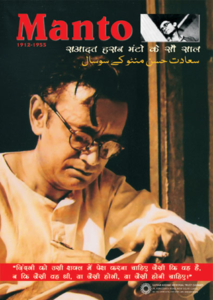 Manto exhibition, SAHMAT.
Manto exhibition, SAHMAT.
 Manto exhibition, SAHMAT.
Manto exhibition, SAHMAT.
Sadaat Hasan Manto wrote searing fiction about India. His short stories make up a double-edged legacy all of us share, whether we read the stories in the original or in translation. Manto’s stories were about a nation-in-the-making, but they force us to confront the “ideas of India” battling in the already-made nation, now more than ever.
Manto was also a film and radio scriptwriter and a journalist – he did not live in a writerly ivory tower. He was very much a man of the real world, of the streets of his city and country. He was a thinking man of his times, driven to anguish by the partition that killed, raped and looted; destroyed lives, homes, histories and roots; and stained almost every aspect of what makes people human. It wasn’t just visible upheaval Manto reacted to. He was equally concerned with hidden tumult, both in the minds of actors of violence and of those acted upon. An English translation of his story “Mishtake” provides a sharp illustration.
Ripping the belly cleanly, the knife moved in a straight line down the midriff, in the process slashing the cord which held the man’s pyjamas in place. The man with the knife took one look and exclaimed regretfully, ‘Oh no!… Mishtake!1
Here, in a few graphic lines, Manto captures communal prejudice, and the hatred and violence it breeds. Here’s the division and heartbreak communalism creates; not just in the minds and hearts of the “subjects” – whoever happens to be the “victim” of the moment – but in the perpetrator’s psyche.
The Kannada critic and cultural commentator D.R. Nagaraj wrote, with great insight, that you can get to know a society through its metaphors: “To read fiction is to know the fate of a society through its metaphors.”2 In Manto’s apparently small story, the metaphor of the story is also the metaphor of a society. This double-role metaphor is a big, bloody, fatal mistake. A mistake in history that can never be undone; a mistake that has multiplied itself so it is replayed in the present; a mistake that hangs darkly between us and the future. This many-armed mistake will live as long as the ideology that moves that knife across “different” skin flourishes.
But the word “society” seems to have lost much of its power; it has become a somewhat comfortable abstraction. We criticise “society” or even the “system” quite easily – they seem, in practice, only to include everyone else, not the self. What about the word “nation” then? The word “India”?
India – the idea of India, my idea of India, yours, theirs – is still sharply contested territory. All of us are on the battlefield, part of the struggle to name this thing called India, describe the nation we are part of, that belongs to us, and that we belong to. It’s hard to be too detached from home.
This two-way belonging, which includes us in the nation by telling us who we are, can also become fraught with an exercise of exclusion – a learned, constructed sense of who is not one of us:
The making of the nation involves the shaping of a Self, but also, therefore, the making of an Other. The geography of the nation is not so much territorial as imaginative, for it deals with what constitutes a people or a community, with ways the land has been lived on or worked over, with boundaries that include and exclude, with centres and peripheries… The discourses of the nation encode belonging and alienation… Literary and historical narratives, as well as various other imaginative artefacts, set up and consolidate the logic of the nation. Despite its disavowals, culture is also politics and play a key role in the shaping of civil society.3
How then do we look at our home, our nation and, most of all, this act of simultaneous inclusion and exclusion, through Manto’s stories?
Like “Mishtake”, “Khol Do” is a communal battle fought on an individual body. But here the battle for dominance takes place on the site of the female body.
“Khol Do” contains more irony, more suffering, than it would seem possible within the confines of a short story. It is set in the riot-torn times of partition, when life meant surviving trains full of bodies, some dead, some half-alive; refugee camps; and a constant sense of menace, with danger or death round the corner. In the story “Khol Do”, Sirajuddin runs with his daughter Sakina to escape the rioters. Sakina’s mother has begged her husband to let her die –her entrails are already hanging out – and save their daughter. As they run, Sakina’s dupatta falls, and her father tries to retrieve it. Let it be, she screams, then he loses her, though he has the dupatta. In the refugee camp he is in, he tries desperately to find her, then asks a band of “social workers” to help. They find her, but they don’t rescue her; she is raped; and Sirajuddin finally finds her in a hospital. At this point, the story forces him, and all of us, to name the unnameable damage a combination of communal and gender violence is capable of.
There was no one in the room. Only the body of a girl lay on the stretcher. He walked up closer to the girl. Someone suddenly switched on the lights. He saw a big mole on the girl’s face and screamed, “Sakina!” The doctor, who had switched on the lights, asked, “What’s the matter?” He could barely whisper, “I am… I am her father.” The doctor turned towards the girl and took her pulse. Then he said, “Open the window.” The girl on the stretcher stirred a little. She moved her hand painfully towards the cord holding up her salwar. Slowly, she pulled her salwar down. Her old father shouted with joy, “She is alive. My daughter is alive.”
The doctor broke into a cold sweat.4
The object of the violence between man and man, and, as collateral damage almost, the violence between men and women, is for Sakina to be completely subdued. To hand over possession of her body, and the territory of self, to men – not just the men who raped her, but all men. This is the chilling suggestion of the story: when men fight their battles of hatred on the site of a female body, even the father becomes just another man. A man she has to open herself up to, untie her pyjama strings for. The world is divided and subdivided, into religious communities, into men and women, into attacker and attacked. And so upside down is such a world, that not only do we have to take in her response – pulling down her salwar for any man, even her father; but also the fact that Sakina’s father does not see what she is doing. All he sees, joyfully, is that she is still alive.
Violence against women in general, and violence against women of certain castes, communities, tribes and classes, continues in our India all these decades later. Sakina’s ravaged body and Sirajuddin’s ravaged mind are not yet memories.
The story “Socialism” moves from this perennial site of conflict in the nation – then and now – to another.
He loaded all his belongings onto a truck and was driving to another town when he was waylaid by a mob. Eyeing the goods greedily, one man said to the other, ‘Just look at all that booty he is decamping with.’
The owner smiled proudly, ‘What you see here is my personal property.’
Some of the men laughed. ‘We know.’
There was a yell from the mob, ‘Don’t let this capitalist get away. He is nothing but a robber with a truck.’5
The mob is greedy, but this time the mob is correct. All these years later, we recognise the man. We can update the make of the truck and the nature of the personal belongings. But the man is the same; so is his protest about the sanctity of personal property; and so is the “scary” mob that is telling the truth about him. In fact, the word “mob” could, arguably, be replaced with “crowd”. This crowd, perhaps on its way to becoming a mob, is still speaking for the “masses”. At any rate, Manto knew his crowds, masses, mobs, and all the in-between versions. He knew the open and hidden transactions that take place across classes.
Then there’s Manto’s masterpiece, “Toba Tek Singh”, which pulls us back to the nation, our idea of India, and our daily struggles with both old and new manmade borders. If Saadat Hasan Manto were alive today, would he write his story “Toba Tek Singh”?
He would probably write it again, word for word.
In a writer’s world, history is not an extraneous, “objective” outside force. History is not abstract or official. It lives, it is capable of pain and suffering, it can bleed. History takes on the shape and skin of people, their unofficial and unheard thoughts, fears, hopes. History is in the girl who is raped so often she pulls down her salwar and spreads her legs like a zombie even though it is her distraught father who has come to see her. In the man who realises, but only after he has committed murder, that he has made a “mishtake” because his victim belongs to his own community. In the mad man Toba Tek Singh, who prefers to die in a no man’s land to living in a country where borders can spring up overnight.
“Toba Tek Singh” is set two or three years after partition; it was first published in 1955. But the story speaks to us like today’s news, its pain and truth not blunted by the years. All these years later, Toba Tek Singh, like his creator, lives. If he stood at Wagah Border today, between the gates of India and Pakistan, we would understand every mad word he says. Why? The story of partition is not the story of a moment because it does not stop at 1947. It is part of the subcontinent’s stories of exile, movement and resettlement.
When fiction writes history, literature becomes a unique source of historical data. Fiction records violence; but it also hints at the unnamed and often unnameable guilt and shame of it all. It does more. In its human embodiments of history, it considers the possibility – and the impossibility – of coming to terms with partition, borders, lines, parameters, maps, insiders, outsiders, us and them. Once again: “To read fiction is to know the fate of a society [or nation] through its metaphors.”
The story “Toba Tek Singh” does this by first insisting that places have to be named. Names explain places, what they are and how they came to be. And a new place that suddenly unfolds before you so your next step may take you into it has to be named. How else will you begin to know it?
Writing and naming the upheaval of nation-splitting and nation-making involves the anxiety of naming places that were other places till yesterday. The lunatics in the asylum Toba Tek Singh lives in are confronted with the bewildering but inescapable question: What is Pakistan? “One Muslim lunatic, a regular reader of the fire-eating daily newspaper Zamindar, when asked what Pakistan was, replied after deep reflection: ‘The name of the place in India where cut-throat razors are manufactured.’6
His answer, the definition of a nation on the basis of religious identity by a lunatic, may still need to be decoded on both sides of the border. The question “What is Pakistan” also alerts us to the fact that like traditions and works of art, nations are created, imagined, then built and consolidated. “The geography of the nation is not so much territorial as imaginative…”7 Governments, official bodies, draw the borders; people have to imagine the nation into being. The idea of watan is not just a house, or a country or a land; it is a sense of place, of belonging, of rootedness. This sense means imagining a collective – a nation – while keeping alive difference and diversity.
With the somewhat shaky answers to the question in the story, “What is Pakistan”, we move on to the next task in the narrative of both story and nation: the new place with a new name has to be located. But the question “Where is Pakistan located?” dislocates Toba Tek Singh and his fellow inmates. It is, at first, a literal dislocation; then it is a dislocation of an essential sense of belonging:
If they were in India, where on earth was Pakistan? And if they were in Pakistan, then how come that until only the other day it was India?
… Sialkot, which used to be in India, was now in Pakistan. …Lahore, which was currently in Pakistan, …could slide into India any moment. It was also possible that the entire subcontinent of India might become Pakistan. And who could say if both India and Pakistan might not entirely vanish from the map of the world one day?8
Confronted by the human (or philosophical) dimensions of naming but also the politics of naming, one lunatic climbs a tree and says he does not want to live in either India or Pakistan but in that tree.
The hero of the story is an unlikely hero called Bishan Singh. But the times are so uncertain that even the names of people don’t stay fixed. Bishan Singh comes to be known by a name that leaps from the metaphor of naming places in times of violent change to that of naming people in the throes of dislocation. Bishan Singh is called Toba Tek Singh, the name of the village he comes from; a village significant only because no one is quite sure where it is – in India or Pakistan.
The narrative moves on from names – a word or two – to a whole sentence, a paragraph, a language. What language can express the madness of borders becoming more important than people? Of borders taking over people’s homes, families, past and future? Toba Tek Singh speaks in variations of a secret formula: “Uper the gur gur the annexe the be dhyana the mung the dal of the Pakistan and Hindustan dur fittey moun.” His “nonsense language” articulates the madness, the incomprehensibility, of what he is living through.
If we probe the language metaphor, we find some vexing layers of meaning. The story – and real life – lead a “bilingual” existence. Both government-speak and human-speak– what should be citizen-speak– are part of life. But only government-speak seems to makeliteral sense, though it does not make actual sense; that is, it is essentially meaningless in human terms. (Parenthetically, we must remember that it is this official language that will create and disseminate “the vocabulary of the nation”). And human-speak, when not allowed to be citizen-speak, becomes lunatic-speak. The incredible irony of “Toba Tek Singh” is that it is his lunatic-speak that yields the meaning of the story to us.
So both uncertainty and hatred hang poisonously in the air in Manto’s story, a story where language itself is rendered insane by the disturbing questions raised. Even as the nation is created, and its language tested out, its narrative is challenged.
When fiction writes history, we look at the other side of the embroidered cloth. We see the upheaval in human terms, in terms of human costs. What about the great driving force of the time, nationalism? There’s very little of this in the story. In fact, Manto prophetically gives us a whiff of today’s false nationalism. There is a sharp little hint of a perverted nationalism that turns the call of the freedom movement, patriotism, into jingoism. Manto would probably expand on this theme if he were with us today. But even then, he knew that an exclusionary nationalism was best relegated to the lunatic asylum. “One day a Muslim lunatic, while taking his bath, raised the slogan ‘Pakistan Zindabad’ with such enthusiasm that he lost his footing and was later found lying on the floor unconscious.”9
But the sane inmates (and most of the outside world) are spared this sort of accident. “Not all inmates were mad. Some were perfectly normal, except that they were murderers… They probably had a vague idea why India was being divided and what Pakistan was, but, as for the present situation, they were equally clueless.”10 Bishan Singh asks a guard, “Where is Toba Tek Singh?” The guard says “…where it has always been.” Bishan Singh persists: “But in India or Pakistan?” The sane guard knows as little as Bishan Singh. “In India… no, in Pakistan.”11
The story seems to be asking us some basic questions about the formation of the modern nation state: is it imposed “from above”? Are the human constituents of the nation accidental constituents, kept in the dark about what they are to think of as their country and their home? To which they must commit loyalty, maintain a bond of love? Such questions create an impasse in the story, and in the real life of making nations and borders. What “resolution” does the story offer?
At the end of the story, when the exchange of lunatics takes place at the border, Toba Tek Singh is pushed and pulled by the border guards. But Toba Tek Singh refuses to move. They give up; he is “only a harmless old man”. Left there overnight, this pathetic old man stands in “no man’s land on his swollen legs like a colossus”. Toba Tek Singh grows, through the long night, into the wounded but still standing figure of humanity. And when he collapses in the morning, “There, behind barbed wire, on one side, lay India and behind more barbed wire, on the other side, lay Pakistan. In between, on a bit of earth which had no name, lay Toba Tek Singh.”
In real life, the search for resolution continues, whether it is between “us and them” as in India and Pakistan; or “us and them” as in the borders being drawn within India day after day. Manto lives, because we still cannot confine his words, his fiction, to the safety of a museum, a library; or to what was true, but is now past. Manto lives on because his fiction still holds up a faithful mirror to the India we live in today.
Notes:
1. Translated by Khalid Hasan for Mottled Dawn, Fifty Sketches and Stories of Partition, Penguin India, 2004.
2. Introduction to Kannada section in A Southern Harvest, ed. Githa Hariharan, Katha Regional Fiction, Katha-Pupa, 1993.
3. Introduction to Women Writing in India, Volume 2, eds. Susie Tharu and K. Lalitha, OUP, 1994.
4. Translated by Alok Bhalla. See https://zjeddy.wordpress.com/2012/05/11/thanda-gosht-by-saadat-hasan-manto/.
5. Translated by Khalid Hasan, 2004. See http://indiauncut.blogspot.in/2006/10/saadat-hasan-manto-and-socialism.html.
6. Translated by Frances W. Pritchett. See http://www.columbia.edu/itc/mealac/pritchett/00urdu/tobateksingh/translation.html.
7. Tharu and Lalitha, 1994.
8. Ibid.
9. Ibid.
10. Ibid.
11.Ibid.
This essay was first published in Guftugu, the e-journal of culture published by the Indian Writers Forum.
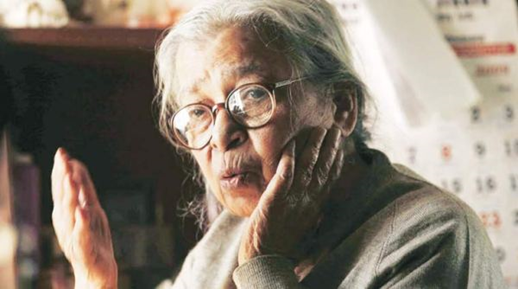
Mahasweta Devi. The Indian Express.
 Mahasweta Devi. The Indian Express.
Mahasweta Devi. The Indian Express.
Excluding the people
Cultural practice does not recognise borders. Militarising it reduces it to a dangerous monolith.
The masks came off soon after condoling writer Mahasweta Devi’s death. Unmasked, the right-wing pseudo-nationalists were on the prowl for their daily target. They found it in a play staged in the University of Haryana; the play was based on Mahasweta’s story, “Draupadi”. The attack by the Akhil Bharatiya Vidyarthi Parishad (ABVP) was to convince us that a story, a story that exposes violence against a woman activist, a story by a writer you have just praised, can turn anti-national.
Is this hypocrisy? Ignorance? Habitual hate-mongering? Or all this and something more, a choice between culture that includes people, and culture that excludes people? Recently, inaugurating a conference organised by the Indian People’s Theatre Association (IPTA) in Indore, filmmaker M.S. Sathyu criticised the shrill calls to keep Pakistani artistes out of India. What has now become the standard of “debate” followed: the IPTA conference was disrupted. This attack, by the right-wing Bharat Swabhiman Manch, was to convince us that IPTA is anti-national. Either the Manch “nationalists” do not know of IPTA’s role in the independence movement, or its attempts to strengthen people’s culture; or they do not know of the conspicuous absence of the Rashtriya Swayamsevak Sangh (RSS) in the freedom struggle. Or the pseudo-nationalists want militarised culture, so that the practice of people’s culture — inclusive, with no borders within India or across the world — becomes “anti-national”.
Consider the project of shrinking culture by drawing borders within India. There’s a fear lurking in the strident accusation of “anti-national” that so much of our cultural work, and so many of our cultural events, are now charged with. It’s the fear of what happened last year. The powerful chorus of voices raised by writers, artists, performers, academics and scientists across caste, gender, community, language and region, insisted that Indian culture is a living system of multiple voices, multiple narratives and counter-narratives.
It’s the fear of what continues to happen: the re-energised Dalit movements, the revulsion caused by atrocities against tribals, the murder of rationalists, and Muslims such as Akhlaq, the suppressing of youth in campuses, and, of course, the insistence that educational and cultural institutions are spaces for discussion and debate. The pseudo-nationalist opponents of culture are afraid of the insistence on democratic rights, freedom of speech, dissent, reason, a scientific temper. They are afraid of all those who speak for an inclusive culture, rather than a militarised culture that excludes more and more people.
A militarised culture finds new ways to exclude people every day; whether it is actor Nawazuddin Siddiqui kept out of the Ramlila or Muslims out of garba events, or whether it is asking Urdu writers to sign an undertaking that they will not write anything “anti-national”. This is the context for the call to ban actors with Pakistani citizenship in Indian cultural projects. The target here is not Pakistani “artistes”. It’s our own citizens, whether writers, filmmakers or artists, and their commitment to practising culture that does not follow an officially sanctioned script. With all the jingoism in the air (and on air), the time is ripe to extend militarising the nation to militarising cultural practice. The right-wing dreams of India in uniform, preferably khaki.
If we let this happen, there will be no Indian culture left. Indeed, we will lose any kind of culture, because cultural practice does not recognise borders within or outside India. We can condemn the terror, or the wars states and state-backed groups inflict on people, ours and theirs, wounding people, jawans and civilians, killing them, taking them away from the real business of life. But do we condemn people? Men, women and children who have nothing to do with the power games states play, people who are not hate-mongers, who only want peace so they can farm their fields, earn for their families, study, pray, and make their music and film and poetry?
People’s culture shows us the way out of the jingoist, militarised nightmare of borders within India, and borders between Indians and other nationalities. People have practised their own borderless culture in the past, during times more tumultuous than ours. Only a decade after Partition, there was an example of collaboration between Indian and Pakistani artists; the kind of inclusion that can and must happen in people’s culture. A 1958 Urdu film, “Jago Hua Savera”, was not about rulers, borders or patriotism. It was about the hard lives of common people — the fishing community in a village near Dhaka, suffering in the clutch of moneylenders. The script, lyrics and dialogue was by Faiz Ahmad Faiz. Faiz’s script was inspired by a Bengali story by Manik Bandopadhyay. The music was by Timir Baran of Calcutta.
Closer in time, in 1997, six of us Indian writers were invited to talk to six Pakistani writers on the fiftieth anniversary of independence. The grand old man of letters, Intizar Husain, spoke for the cultural community on both sides of the border. He said, “So much that is important to me as a writer is on the other side of the border. The Jataka Tales, Meerabai’s bhajans, the Delhi I knew. How do I remain a writer if I pretend all these are no longer mine?”
So what kind of culture should we strengthen? History has examples of the choice we have, both as a nation and as people. In 1935, one of the best known propaganda films was made. Leni Riefenstahl’s film “Triumph of the Will” was commissioned by Hitler. The theme Hitler had in mind was Germany’s glory under his leadership. But even as the film glorifies the official narrative of the Nazis, we can see how the nation’s “glory” involves excluding people, whether Jewish, Communist, or Germans with a more inclusive, humane view of the world. In stark contrast, Mahmoud Darwish, often referred to as the Palestinian national poet, wrote the Palestinian declaration of independence in 1988, and many poems of resistance that are an integral part of every Arab’s consciousness. But he also wrote, just after the 1967 war, a tender poem about an Israeli soldier, “A Soldier Who Dreams of White Lilies”. Darwish responded to criticism with what could be the motto of every practitioner of an inclusive people’s culture: he would, he said, “continue to humanise even the enemy”.
Who do we want to emulate, we who own culture, we who make culture to express our strongest hopes, dreams and fears? Riefenstahl or Darwish? The ABVP or Mahasweta Devi? Bharat Swabhiman Manch or IPTA? Only a culture in touch with people’s lives, open to dissenting voices, this side of the border or that, can keep culture, its myriad voices, from being reduced to a single dangerous voice.
First published in The Indian Express, October 2016.


Nursing god’s countries
In Quebec, the wind sings with a hoarse throat. It’s because it sings the same song all the time that it sounds like a moan. It’s my first winter.
In Munnar, rain sprays the fronds of the coconut trees, making them greener. The rain has settled down to a steady rhythm, the way it does after it has said its piece in one great burst of a downpour. Because the rain is calmer now, I can hear it better. Or I can make better sense of it. I can translate dripping whispers into words that wing from Munnar to Quebec.
Monsoon lullaby, coconut lullaby. The wet leaves come so close to me they make a blur of green. The green leaks into my head whether I am asleep or awake.
My little girl must be watching the rain, listening to it. What does the rain tell Binny Mol that it doesn’t tell me?
In the last photograph I got, she was not such a little girl. She is growing, she is now half girl, half woman. I prefer photographs to telephone calls or emails or Skype. I can look at the photograph alone at night and travel where I like. That’s the time I learn my child again, make her completely mine.
There’s a dream in her eyes; I recognise it because it lived in my head once, making me look like Binny Mol. I want to reach into the photo, tenderly spoon in a dose of bittersweet medicine: nurses should not dream too much.
Binny Mol pays no attention to me. I have to leave her with the rain, let her face dissolve into the leaves.
It’s another mother and daughter I see now. I have become the daughter, and Ammai’s words do not sound like rain at all. They are loud and clear as if she is still giving orders to the junior sisters though she is retired.
Ammai wanted, always, to go somewhere; at least as far as Delhi, Mumbai. But it never happened. Her cousins and sisters-in-law made their way to Muscat, Kuwait, Saudi, Manama, Dubai, names that slid down our tongues as easily as Munnar, as if these unseen places belonged to us or we belonged to them.
My going away was almost as good as Ammai’s living as she wanted to live. We dreamt our separate dreams together.
We woke up every time we counted our notes. Hers for Good Angel Private Institute, mine for the agent. The bits of paper, the certificates and the rupee notes, rustled in my hands like promises. Almost a ticket. Ammai’s ticket out of the country too, though she would stay at home. “Go alone, you’re a brave girl,” she said. “I’ll find you a good match later.”
But when she heard I was going to Bahrain, she said angrily, “Why Bahrain? It’s not a Christian country!”
Now, when she does not get angry, or ask sharp questions, I have an answer. Bahrain, Munnar, Delhi, Quebec, where are her Christian countries?
What I actually say to her these days is different, but also true. I sent her a picture of the church Annama, Sara and I go to most Sundays. We stood arm in arm for the photo. Sisters in arms, straight and serious, not laughing like the photos people send when they are on holiday, enjoying themselves. I described the inside of the church to Ammai because we didn’t want to aim the camera at the altar and stained glass windows like tourists. I find photos are easier than words though; they say what is not so easily said.
All those years back, I didn’t say anything when Ammai was worried about my going to Bahrain. Or when she put her arms around me before I left, saying, “May Jesus travel with you.”
But by then I was Flow-rens, not she.
The first time she told me about Florence, I was a girl like Binny Mol. My mother told me stories of the lady who travelled with just a lamp and a mission as luggage. Every time she unpacked her bag, she healed someone.
My mother’s stories always had something useful in them. I could pack them in plastic, seal them with a burning candle and take them with me. Like dried fish or pappadam or pickles, things that taste better when they keep. Or when you have made a vow to serve and send home the money they need.
“A nightingale is a bird,” my mother told me when I was a child. “It’s a little like a koel.” I imagined a koel, a nightingale in a white coat, singing a flowing lullaby. Tharattu pattu. A lullaby that can put a baby to sleep because she is at home, safe and loved.
Some years later, when I had become Florence in Manama, it was I who sang to the koel. I watched my friend Sumithra next door and learnt to coo as I rocked Binny Mol. Aaarero, raaro, raaro. Aaarero, raaro, raaro. Her eyes would glaze as if I had given her the right drug. She would stare at me as if she would never let me go; then her eyes would finally close. My heart swelled till I could hardly breathe. It didn’t matter whether I was nurse or mother or both.
The photos I send Binny Mol are different from what I send Ammai. I send her photos of myself, standing tall inside a snowy postcard of a wonderland, smiling and smiling. My smile may show her the future; for now, it is my unsung lullaby.
But sometimes I worry: is it easier to sing, or to be a mother, in a green place?
I have never seen so much white before, except on uniforms, or saris and mundus. On clothes.
Here it is skin; white skin. And it’s not just people who wear white skin. It’s the ground, the roofs, the trees. Some of the trees are naked under the white. Other trees still have leaves; hard leaves. Naked or clothed, they have to bear the weight of the snow. Their skin has to be thick enough for the layers of white, like the heavy makeup on a Kathakali dancer. Sometimes the doughy clumps make a pretend nose or false ears. The bush I see from my room has two flat piles of snow before it. A pair of floury feet. Any minute now, the bush may learn how to walk with those misshapen feet. It may walk slowly, as if recovering from an operation, take one small step at a time, swaying like a Kathakali dancer, and go in search of a warmer place.
I want that to happen by the time Binny Mol is here.
It’s too soon to tell Binny Mol when she can come here. But I can almost see it: we will have a spick and span little Canadian home with heating. She will go to a free school. She will learn nursing at a place better than Good Angel, or study something else, even medicine. A good salary for not working herself to the bone. She will be like me, a career woman. But please Jesus she will do better than me, much better and more easily. When we come home in the evening, we will find Munnar in the big bottle of coconut oil, the appam pan, the beef in the fridge ready to be turned to stew.
If Paulose were not under Bahrain’s brown earth, we would be a complete little family, the kind that laughs in Christmas card photos.
Paulose, I say to him sometimes in my head: I did it somehow. Our plan didn’t fail, even though I went home without you. Ammai wrapped her arms round Binny Mol. She blessed me when I went back to Bahrain alone. “You take god’s country where you go,” she said.
The second time in Bahrain: saving all over again, sharing a tiny place with sisters without families. But Paulose, Binny Mol and I shared the photo frame sitting by my bed like a guardian angel. The angel reminded me of the day Paulose came home from the power plant to say he had got a job. The look on his face then – that’s what I had to hold, like a photo, to prove our plan was beginning to work. It was no longer just my salary.
But too often that look of pleasure would slip in time, change into the look of a dying man. That actually came later, the pain, guilt, worry about me and the child, the irregular remittances home for months. Everything was getting gobbled up by his cancer, not just his body.
Sometimes I would pretend he was just another patient, another job to be done well. Bodies are all the same; so strange, because each body is different.
When Paulose and I met, two weeks before we were married, I could only see the difference. He was an engineer. He didn’t have a degree, only a diploma. But his family lived in a house with a compound, on a nicer street than ours. It was time for me to marry, Ammai said. And all Paulose wanted to do was emigrate. That is how we made a match. If I were not in Bahrain, his family may not have approached my mother. I used to tease him about this later. Though he never denied it, he laughed and took me in his arms.
Once he joined me in Bahrain, found a job, got me pregnant, he became less of a stranger. We had something between us. We found it, or it found us, and it grew like a strong tree with spreading roots. If he was the man of the family, I was the one who had got him to Bahrain. I don’t think he ever forgot that. But I did. I only remember it now because I have become the good match in place of Paulose. I still send money home to his parents and brother and sister, not just my mother and daughter. His family still calls me one of theirs. Once in a while, but only on a bad day, I think: remittance keeps even an in-law family together. The moment passes quickly. It’s too late to quarrel with Paulose. I have to forgive him for dying.
Most of all memory is what helps me forgive. It comforts me and lulls me to sleep in my single bed.
The memory I like, the one I have to ration and not take to bed every single night: it was one of those evenings when I got back from hospital later than usual. I let myself into our flat, the thought of cooking and bathing the baby making me feel even more tired. My back and legs were punishing me for standing or walking or bending all day. Then I noticed the fragrance from the kitchen that had reached the front room; dinner was waiting for me. And I could hear Paulose singing in the bedroom.
I tiptoed to the door and stood there, listening. He was singing one of the songs I had learnt from Sumithra. A royal lullaby, she called it.
The lullaby which once put a little prince to sleep in a palace in Kerala had made its way to Bahrain without a visa. It was now in the throat of the bear-hairy man who worked with machines all day and could still hold our baby with tenderness.
Omana-thing-al kidavo… Both Paulose and I loved this song because it said nothing about sleep, but always, like magic, it put Binny Mol to sleep.
Binny Mol must have been fast asleep by now, dreaming good dreams, but Paulose was still singing. He was asking her, of all the lovely things in the world, which one she was. Was she his full moon? His lotus? His doe?
Our streak of luck. Our sweet singing bird. Ours, then only mine. My tender green leaf.
Green leaf, Binny Mol, Munnar.
When I went back to Bahrain alone, I would work all day with the Malayali nurses I stayed with. Every night, I dreamt in only one colour: green, all the shades of green. It was like a sickness, but it let me go home as easily as sleeping. Then the dreams stopped.
There was green in Bahrain too, but it all looked like pictures to me. The palm trees were real, but they were all in a line, obedient patients for the Indian and Pakistani gardeners to keep beautiful. It was clean like a good hospital. You know the brown is there, the dry skin of a sick old man. But you cream it, make it look fresh, because you have to keep up appearances even if you are dying. It makes everyone feel better, doctor, nurse, patient, family.
In any case, the manicured green faded where we Malayalis lived. Huddled together, we could make believe we were home and not home. We could be in Kerala and stay away from it.
When the papers came through for my going to Canada, the old green-dream sickness came back. Maybe it was all the expense and worry of applying again, emigrating again. Maybe it was because that was the time the nurses were striking back home in Kerala. I saw the pictures of nurses I knew in the midst of strangers, strangers who looked like me, dressed like me.
For a day or two I wanted to go back. Not to grow old, or die in my ancestral village, but to be a sister among sisters, hold up placards like them, or shout slogans, demanding my rights. I have never shouted a slogan in my life, but maybe I could do that in Kerala, make up for all the things I can be in Bahrain or Canada but not at home.
I didn’t go back. I didn’t learn to shout slogans. But I went all the way across a map glistening with blue-gray water, and found Quebec. One more of god’s countries to nurse.
Some days, I feel I am in a strange dream alone. The dream is all white. It is quiet, or it speaks only French. But there are days when the work or the paycheck or the time spent with other sisters shakes this feeling off me.
Green, brown, white. The changing colours pile up, they go from place to place. Bodies remain the same. They have to be taken care of.
I will work at it, my first Quebec winter, as I worked through all those green winters, the clinics in Munnar and Kochi and Bangalore and Bahrain.
By the time I get the papers for Binny Mol, I will learn how to sing even when the wind blows hard, turning green to brittle orange, brown, then white. It will be like learning a new language. Only the meanings of words will still be in Malayalam.
My certificates have piled up; the hours I have to be in the hospital have shrunk. I no longer change sheets or clean skin with a wet sponge. I have learnt to draw blood so the needle is light as a butterfly on the vein. “Done already?” the pale young man asked me the other day. “I didn’t even feel it.”
I felt it though. I felt the glow of a woman even stronger than Ammai, and with a longer streak of luck.
First published in Garden and Spring by the Abraaj Group Art Prize 2014, and David Davidar (ed) A Clutch of Indian Masterpieces, Aleph Book Company, 2014.

